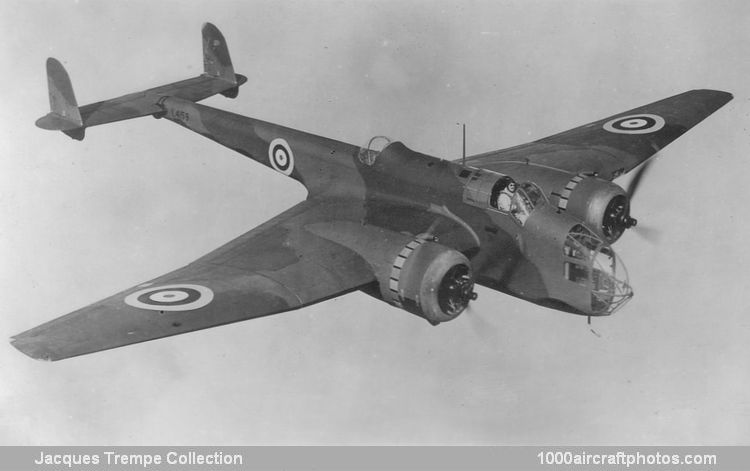01/31/2018. Remarks by Johan Visschedijk: "The H.P.52 was the Handley Page response to Air Ministry Specification B.9/32 calling for a twin-engine day bomber for the RAF. Other companies tendering for the contract were Gloster, Bristol and Vickers. The last-named company proposed the Type 271 and this design saw production as the Wellington to Specification B.29/36.
The Handley Page proposal resembled the H.P.47 as the crew were accommodated in a deep and narrow forward section of the aircraft and the twin-finned empennage was attached to a very slim tail boom which afforded a clear field of fire to the gunners in the dorsal and ventral positions. The sharply tapered wing shape was also featured in the H.P.51 and its development, the Harrow. The wing was mounted in mid-fuselage with the bomb bay underneath in the bottom of the fuselage. Leading edge slats were fitted on the outboard wing and large slotted trailing edge flaps were used.
The prototype H.P.52 was powered by two Bristol Pegasus P.E.5S(a) nine-cylinder air-cooled radial engines with two-speed superchargers and driving three-blade de Havilland controllable propellers. Serialed K4240 it was flown for the first time by the company's Chief Test Pilot Major J.L.H.B. Cordes on June 21, 1936, from Radlett. Apart from its unusual appearance it was notable in being the first Handley Page aircraft to have a retractable landing gear.
Early in 1937 the issue of Specification B.30/36 covered a production order for 180 aircraft and at the same time another order, covered by Specification B.44/36, was received for production by Short Brothers and Harland of 100 H.P.52s powered by the 1,000 hp Napier Dagger VIII 24-cylinder air-cooled H-type engine. Serialed L4032 the first production machine flew on June 21, 1938, and was christened Hampdon on June 24. The production machines were powered by 980 hp Pegasus XVIII engines (production version of the P.E.5S(a)) and had smoother nose, dorsal and ventral transparencies than the prototype. They also had increased dihedral on the outer wing panels. Armament at this stage still only consisted of one fixed forward-firing Vickers gun.
The very slim tail boom of the Hampden required that this be split down the middle during production to allow installation of all controls and wiring before final assembly. With the front and center fuselage built as separate units and the wing center section built independently of the outer panels, the Hampden became the first type to be built on the Handley Page split-assembly system, later to be used on the Halifax.
As a result of increased RAF requirements, further production orders were placed with English Electric at Preston and the Canadian Associated Aircraft group, which latter organization was formed specially to build the Hampden. It had been intended that the Canadian machines should be powered by 1,100 hp Wright Cyclone GR-1820-G105A nine-cylinder radial engines and in January, 1941, English Electric fitted an aircraft (s/n X3115) with these engines and that became known as the Hampden B.Mk.II; however, no production machines had the Cyclone.
During 1942 the number of Hampden bombers on raids was gradually reduced and by mid-September it was withdrawn from frontline service. A few Hampdens continued to operate during 1943 on meteorological duties, these modified aircraft being known as Hampden Met.Mk.Is. A large number of Hampdens was shipped to Canada where they were used by No. 32 Operational Training Unit at RCAF Station Patricia Bay in British Columbia until finally being struck off charge on August 2, 1944. The sole Hampden B.Mk.II X3115 served with No. 415 (RCAF) Squadron from 1940 until permanently grounded in December 1943.
With the intention to produce the Hampden under license, the Swedish AF acquired the fourth production example (serial L4036), powered by the 1,010 hp Pegasus XXIV engine it was delivered on September 24, 1938. It was given the Swedish designation P.5 and the serial I-90, however, the license production plan was dropped. In November 1945 it came on the Swedish civil register as SE-APD and was used by SAAB as a flying test bed for electronic equipment. It was withdrawn from use on November 17, 1947.
A modified version of the H.P.52 was proposed in November 1935 to meet the requirements of Specification M.15/35 for a twin-engine torpedo-bomber. This specification was not proceeded with but in 1942 the T.B.Mk.I torpedo-carrying variant of the Hampden was produced. This version could accommodate a standard 18 in (46 cm) torpedo internally, and two 500 lb (227 kg) bombs could be carried under the wings. Reportedly 141 production Hampdens were modified to T.B.Mk.I standard and were used by squadrons of the RAAF, RAF, RCAF and RNZAF. The last Hampden T.B.Mk.I went out of use in December, 1943.
